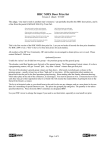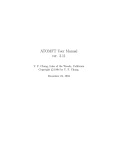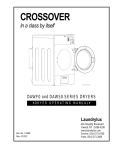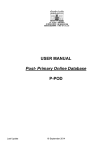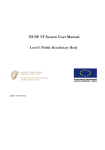Download Refraction, Weather Station Components, and Other Details
Transcript
Refraction, Weather Station Components, and Other Details for Pointing the GBT Ronald J. Maddalena August 7, 2002 I. Introduction In GBT memo 110, Sebastian von Hoerner gives a good outline of how one can successfully model the repeatable pointing errors of the Green Bank Telescope (GBT). I will discuss in this memo a few issues that he brings up. Von Hoerner, for example, suggests that someone review his work on refraction. My conclusions about refraction have important implications for the quality of components we will need to purchase for the GBT weather station. I will briefly review my experiences with using the fitting technique that von Hoerner strongly suggests and, among other things, contrast it with the technique put forward by J. Condon in GBT memo 75. II. Refraction Von Hoerner's description of pointing applies mostly to the "traditional" pointing module described by Fisher, Hogg, and Macknik in GBT memo 103. However, the corrections for atmospheric refraction described by von Hoerner are not part of the pointing system described in memo 103 but apparently must occur at a higher level in the control software. R.M. Smart (1977) presents the most general formula I have found for calculating refraction: (1) where Eobs and Etrue are, respectively, the observed (apparent) and true (airless) elevations. n0 is the index of refraction at the surface of the Earth, n the index of refraction at distance r from the center of the earth, and a the radius of the Earth. Note that E is always positive except it should be zero at E=90 . To use Equation (1) requires knowledge of how n changes with height (which requires knowing how, for example, the barometric pressure and temperature change with height). Joe Brandt suggested I look at a routine he obtained from Starlink that supposedly calculated E extremely accurately. The routine apparently solves Equation (1) using a multi-layer model of the atmosphere. The comments that came with the code are insufficient for me to understand the assumptions of the model and to estimate the accuracy of the results. Comparing the results of the Starlink code to the models I describe below, I found that the Starlink code, at radio wavelengths, has a significantly different weather dependence. I cannot recommend the Starlink code until someone understands the cause of the discrepancy, which could amount to, under some not-toounusual circumstances, a 10" difference in E. Since one usually cannot obtain weather information as a function of height, one must turn to simple models. All the models I have found assume that Equation (1) can be adequately simplified to either: (2) or (3). The models assume that E can be described by n0, which depends upon weather conditions and the wavelength of the observations. The functions, f and g, depend solely upon either Eobs or Etrue and not upon weather conditions or wavelength. The constant, C, in the equations is either predicted by theory or derived from a least-squares fit of measurements to the above equations. Models differ in how they calculate n0 and the form of the functions. For the rest of this report, the reader should be aware of the expected approximate values of C, n0, f and g. The functions f and g can be approximated to a very low accuracy by cot(E). At E=5 , the lowest E the GBT can obtain, fg10. Typically, (n0-1) is 310-4. If E is in units of arc seconds, C is about 2105". Thus, C(n0-1)60" and, at E5 , E600". Weather conditions can alter (n0-1) and E by as much as ±15%. The possible failings of the model are obvious. Although most of refraction occurs at heights less than 1 km, one shouldn't expect the local value of n0 to represent the value of n along the line of sight. One shouldn't expect to have under all weather conditions at all frequencies the same E dependence of refraction. However, since we can only measure the local weather conditions, these models are all we have to help us approximate refraction. I suggest that the GBT software makes use of the equations in the following way (or its equivalent): When an observer enters a source position into the GBT control system in, for example, the J2000 coordinate system, the control computer should convert the position into an azimuth, A, and Etrue. Then, it should use Equation (3) to derive Eobs which it should send to the pointing modules described in GBT memo 103. Since telescopes do not point where they are commanded, the pointing system should measure the actual A and Eobs and pass the values back to the control system. The control system should then derive Etrue from Equation (2), convert Etrue and the measured A into J2000 coordinates, and store the 'measured' position with the data. I think that it is more important to store with the data 'measured' positions rather than 'commanded' positions. I will now describe what I believe are the best f and g functions I have found in the literature. Later, I will give the best models for deriving n0 from local weather conditions. I will then describe the accuracy we can expect from the models and how the desired accuracy affects what kind of weather station components we buy. II.a Functional Form of Refraction Since f and g in Equations (2) and (3) are independent of wavelength, we are free to consider functions derived at any frequency (e.g., from optical refraction curves). The functions I have found in the literature either were derived from simplistic, theoretical models of the atmosphere [see, e.g., §37 of Smart (1977)] or were based on guessing a function that best matched the measured E dependence of refraction. I will exclude the theoretical models since they are not accurate enough for the GBT at E typically less than 15 . 2 Alternatively, one can forego the use of functions and instead rely on tables (or graphs) of measured refraction [see, e.g., Figs. 4-13A and B of Hobbs (1974) or §55 of Allen (1973)]. Whether or not one uses a table of values or a function fitted to a table depends upon the accuracy of the function. Since functions are easier to program, I will continue discussing them. Von Hoerner (GBT memo 110) warns that the function we should pick for the GBT should not diverge at E=0 . This need not be the case for the GBT. Instead, we need functions that are accurate and well behaved between E=5 (the minimum value obtainable by the GBT) and E89 [when E becomes small enough (1") so that it can be ignored]. Sebastian is correct, however, if one is considering a telescope that can reach the horizon. Some models make an additional assumption. At moderate values of E, EobsEtrue which implies f(Eobs)g(Etrue). Some models, therefore, assume that g and f have the same functional form. Near the horizon, the assumption significantly breaks down. At E=15 , for example, g(Etrue) and f(Eobs) already differ by 1" and by E=5 they differ by 15". With these models, one either ignores the error or uses guessing or iteration techniques to derive one function from the other. Von Hoerner (1976 and GBT memo 110) suggests: (4), which NRAO currently uses at the 140-ft and 12-m. The equation does not diverge at Etrue=0 and is zero at Etrue=90 . Sebastian derived Equation (4) from Allen's (1973) refraction table and his function looks to me like it has an accuracy of 1" between E=5 and 90 but that errors grow fast at E<5 . He does not provide a function f but suggests that, for the 140-ft at moderate E, one can assume that f has the same functional form as g. Although Sebastian's assumptions are correct for the 140-ft (with its large beam) and for the 12-m (which cannot observe at E<15 ), if we want to correct for refraction to something like 1" at E<15 with the GBT, then we probably should find a suitable f(Eobs) that fits refraction tables. Meeus (1991) suggests the following: (5), where (6). He says that Equation (5) is accurate to 0.9" for all values of E. Meeus also suggests a g function that has a much larger inaccuracy of 4". I have added a correction term to Meeus's g function that reduces the inaccuracy to less than 1" at E>5 . (7), where (8). 3 Note that f and g are not zero at Eobs=90 . We may want to either ignore the discrepancy, turn off refraction corrections at E>89 , or, better yet, use instead the sufficiently accurate approximation f(E)=g(E)=cot(E) for E>89 . For E>6 , Equation (7) and (4) are equally accurate but, for E<6 , Meeus's and my formulae are more accurate. My recommendation is that we use Equations (5) and (7) for f and g. I also suggest that we continue to look for other refraction models that might be better behaved or more accurate than the ones I have presented. Alternatively, and as a long-range research effort, we might want to measure refraction in real time using an optical telescope aimed at a bright star at approximately the same A and E the GBT is pointing, and then infer the correction we should apply at radio frequencies and at the E the GBT is observing. II.b Index of Refraction The local value of the index of refraction, n0, used in the models of Equations (2) and (3) contains the complete weather and frequency dependencies of refraction. Almost all the methods I have found for calculating n0 can be reduced to: (9) where TC is the local temperature in Celsius, PC and Pw are the partial pressures due to CO2 and water, and Pdry is the partial pressure due to everything but CO2 and water. The total barometric pressure, P, equals P dry+P w+P c. I will use mmHg for the units of pressure. The wavelength dependence of n0 is contained in the wavelength dependence of the B coefficients. The models differ in the values they assign to the coefficients. Table 1 gives the values of the coefficients for the models I think are most appropriate. Table 1: Coefficients for determining n0 from partial pressures. B1 B2 B3 B4 References 103.49 177.4 86.26 4.958•105 Froome and Essen (1969) 104 ... ... 5.2•105 Allen (1973) 103.5±0.1 172.4±0.2 96±12 (5.00±0.04)•105 Crane (1976) 103.56 ... 95.5 4.995•105 Liebe and Hopponen (1977) Since Pc0.0003P (Allen 1973; Crane 1976) we can ignore the B2 term. Since P=Pdry+Pw+PcPdry+Pw, Equation (9) can be simplified to: 4 (10). We cannot drop the B3-B1 term without adding about an arc second error at E5 . To achieve a refraction correction that is better than 1" at E=5 , where Cf(E)2106", we need an accuracy of at least 510-7 in (n0-1). I will now review each of these models to see how well they can be applied to the GBT. Froome and Essen (1969) say that (n0-1) values derived from their coefficients are good to 510-7 between -20 C and 60 C and for Pw<100 mmHg at frequencies less than 40 GHz. Rüeger (1990), in reviewing the accuracy of Froome and Essen's coefficients, says that the accuracy is better than about 110-7 under typical weather conditions but notes that errors grow to 1010-7 under extreme conditions. Rüeger also mentions a systematic error of 3.510-7 introduced by, among other things, Froome and Essen using TC+273 instead of TC+273.15 in the denominators in the equations. We can dismiss Allen's (1973) coefficients because of their suggestive inaccuracy. If Crane's (1976) estimated errors are correct, his model under average conditions gives a systematic error of 510-7 in (n0-1). Crane implies that his model is most accurate below 30 GHz and that errors grow to 1510-7 at 100 GHz due to anomalous dispersion. Liebe and Hopponen's (1977) coefficients are applicable to frequencies between 40 and 140 GHz; but the accuracy of their work is not apparent from their paper. In addition to the model presented above, Froome and Essen (1969) provide an equation that is stated to have an error for (n0-1) of 110-7 for frequencies under 30 GHz and temperatures between -20 C and 60 C. (11) In deriving Equation (11), I have assumed Pc=0 and corrected a significant typographical error in their original equation. Although Equation (10), with coefficients from Froome and Essen, probably would be adequate, I suggest we use the more accurate Equation (11) for the GBT. This will keep the systematic pointing errors from refraction down to about 1" at all values of E. I don't know anything about refractometers but, in principle, we probably could use one at radio frequencies to measure directly n0 and, thereby, eliminate the need to resort to the above approximations. We could investigate if a tipping radiometer would better measure Pw than any of the devices I have mentioned. II.e GBT Weather Station 5 The GBT weather station will have many uses. The control system needs weather information for calculating refraction. Either the control or data analysis software will need the information to correct for atmospheric attenuation. The laser ranging system has to calculate the index of refraction of light. Traditionally, weather information is stored with astronomical data. Telescope operators use the local weather conditions to decide whether the conditions are bad enough that observations should stop. After talking with Dave Parker and others, I have come to the conclusion that the need for accurate refraction corrections determines the accuracy of some of the weather station components we need to buy. Anyone who believes his or her requirements on the weather station are more stringent than for refraction should inform Dave Seaman. To correct for refraction, the weather station must provide accurate values for P, T, and Pw. P and T are measured directly with barometers and thermometers. Pw is usually inferred from devices that measure either dew point (D in C), hygrometers (which measure relative humidity, H, in percent), and psychrometers (which use wet and dry bulb temperatures, Twet and Tdry=TC, in C). If the GBT weather station measures dew point, by definition: (12), where Psat is the saturation water vapor pressure over water or ice. GBT station measures relative humidity: If the (13) (Crane 1977). If the GBT station uses a psychrometer: (14) (Rüeger 1990). Rüeger (1990) suggests the following equations for Psat (in mmHg) which he states has an accuracy better than 0.05 mmHg for standard weather conditions: (15). Here P is the total barometric pressure (in mmHg) and t depends upon which device we use and is either D, Tc, or Twet. To determine the necessary accuracy of the various weather station components, one must differentiate either Equation (2) or (3) with respect to P, Tc, and, depending upon the device, either D, H, or Twet. I have assumed that the errors in measuring these quantities are not correlated. Equations 6 (2) and (3) become very complicated once all the substitutions are done [e.g., Eq. (15) into either Eqs. (12), (13), or (14); into Eq. (11); into Eq. (2)]. To minimize any possibility of error, I used an HP28S calculator, with its ability to do symbolic math, to make not only all the substitutions but also to take the necessary partial derivatives. If I use standard weather conditions for Green Bank [P=700 mmHg, Tc=10 C and Pw=6 mmHg, corresponding to D=2.6 C, H=60%, and Twet=6.9 C], then the random rms pointing error (E) introduced by inaccuracies in measuring weather conditions (P, Tc, and either D, H, or Twet) is approximately: (16) Table 2 gives the rms accuracy of the various weather components that will give the GBT 1" rms pointing accuracy at either E=15 or 5 . I assumed in deriving Table 2 that each component contributes 1"/3. If we buy one component that is more accurate than that specified in the table, then other components need not be as accurate. For example, the VLBA weather station has a more accurate barometer (P=0.5 mmHg), a less accurate dew point device (D=0.5 C), and an sufficiently accurate thermometer (Tc=0.5 C), compared to the values in Table 2. Using Equation (16), the accuracy of the VLBA station is 1" at E=15 and 2.7" at E=5 . Table 2. Suggested Accuracy of Weather Station Components. Device E=15 E=5 Dew Point Hygrometer Psychrometer P ±2 mmHg ±2 mmHg ±2 mmHg Tc ±0.6 C ±0.6 C ±0.15 C D ±0.3 C ... ... H ... ±1.4% ... Twet ... ... ±0.10 C P ±0.8 mmHg ±0.8 mmHg ±0.8 mmHg Tc ±0.25 C ±0.25 C ±0.06 C D ±0.1 C ... ... H ... ±0.5% ... Twet ... ... ±0.04 C At high frequencies, where the small beam of the telescope warrants good pointing, atmospheric absorption usually won't allow you to observe at E<15 . Warmer and wetter weather conditions than the ones I adopted for Equation (16) and Table 2 usually put stronger requirements on the weather instruments but, at high frequencies, one usually shouldn't observe under these 7 conditions. Therefore, we could adopt the less stringent E=15 specifications of Table 2 and ensure 1" pointing accuracy at E>15 with larger errors at smaller E. But, if possible, we should try to obtain components that satisfy or approach the E=5 specifications. III. Other Details Concerning the Traditional Pointing Model For the rest of this report, I will concentrate on how one can take pointing measurements and derive coefficients that can go into the traditional pointing module of GBT memo 103. In GBT memo 105, Carl Heiles and I described a suggested user interface to the pointing system. We were stressing how observers can measure and update pointing during their observations and did not go into detail how staff will use the system to find pointing coefficients. I will not unnecessarily reiterate either the contents of memo 105 or the recommendations of von Hoerner in memo 110. Instead, I will add details and suggestions to the recommendations of these reports. The following sections will give suggestions on pointing observations, data reduction, pointing models, and fitting techniques. III.a Observations for Deriving Pointing Coefficients Probably some of the first observations made by the GBT will be used to establish the pointing coefficients of the traditional model. Since observers, according to GBT memo 103, must rely on accurate coefficients when the laser-ranging and auto-collimator systems cannot function, observations dedicated to establishing accurate pointing coefficients will need to be made routinely to keep coefficients up to date. It is my experience that the pointing measurements made by astronomers as part of their observing are seldom useful for establishing pointing coefficients. Their observations are most often made under non-ideal weather conditions, with varying or atypical equipment setups, or not properly distributed on the sky. Furthermore, astronomers want to measure pointing offsets that will make their experiment successful and should not worry about other astronomers' needs. Staff members, on the other hand, have to provide a pointing system that is useful to the majority of users. Staff must do their job well so that astronomers need to worry less about pointing. They should plan to make observations when the equipment and weather will guarantee the best determination of coefficients. They should plan their observations to give the best sky coverage for finding good values for coefficients. Staff will need to repeat pointing measurements whenever certain components of the telescope are significantly altered (e.g., after encoder modifications or resetting of the subreflector). Obviously, we probably will need different coefficients for prime and Gregorian focus. To test the above suggested model for refraction, we may want to repeat observations at a few frequencies and a wide range of values for P, Tc, and Pw. If we start with the pointing model suggested by von Hoerner (Eqs. 10 and 11 of GBT memo 110), which has nine coefficients, we should anticipate needing something like 100 pointing observations for a good determination of the coefficients. I additionally suggest we have a program that takes a list of bright sources and schedules the telescope to concentrate observations at the 'cardinal' angles that Sebastian suggests. In practice, I have found that 8 concentrating observations in this way is extremely important in establishing an accurate set of coefficients. III.b Data Reduction To find coefficients to the pointing model, the control system must pass to the data analysis software all necessary information. This includes values for P, Tc, and either Pw, D, Twet, or H. Sebastian's model and most others require knowing the A and E of where the source should have been [(Atrue,Etrue)catalog] and the encoder readings where the source was measured to be [(Aenc,Eenc)measured]. [Or, equivalently, (Atrue,Etrue)catalog and the difference between (Atrue,Etrue)catalog and (Aenc,Eenc)measured. Note that astronomers typically do not require (Aenc,Eenc)measured but instead are mostly concerned about the difference between (Atrue,Etrue)catalog and (Atrue,Etrue)measured.] All assumptions that the data analysis software makes in deriving (Atrue,Etrue)catalog and (Aenc,Eenc)measured must be well under 1" for the GBT. The data analysis software, when it reduces the pointing observations, will either need to be given these values by the control software, infer them from other information supplied by the control system, or derive them itself. The analysis software should also supply the fitting program some measure of how good the pointing observation was. For example, if the pointing observation consists of slewing the telescope through a source, the analysis software might fit a Gaussian to the data and pass to the fitting program not only the fitted value of (Aenc,Eenc)measured but also the Chi square of the fit (or its equivalent). III.c Pointing Model In the GBT memo series, there have been two suggested pointing models. In memo 75, Jim Condon suggests not using a physical model and instead suggests using an empirical model consisting of spherical harmonics. Von Hoerner, in memo 110, suggests a physical model. I cannot recommend Condon's pointing model for philosophical and practical reasons. A pointing model made up of empirical terms hides the physical telescope and its pointing characteristics. Unlike physical models, empirical models don't teach us about the structure and may not warn us of possible structural or equipment problems. With a physical model, if two pointing runs produce different coefficients for the same term, since we know why the term is in the equation, we probably could understand what changed on the telescope to produce the different coefficient. With an empirical model, however, a change in a coefficient would be more difficult to trace back to its cause and the significance of a change in coefficient might be overlooked. I agree with Sebastian that we should start with a physical model and add empirical terms to it only if necessary. Empirical terms are a last resort, not a first try. They are prominent flags indicating that our job is not over, that staff doesn't understand the structure well enough, and that more work is needed. If, over the years, we want better and better pointing, we should constantly try to turn empirical terms into ones that have a physical basis. The history of the pointing for the 140-ft, for example, shows that pointing improves in the long run not by adding empirical terms but by replacing them with the correct physical terms. 9 In practice, a model based on spherical harmonics is far inferior to the current physical model used at the 140-ft telescope. I tried fitting spherical harmonics with 30 terms to 140-ft data and could not reduce the rms residuals of the fit to what our current 11-term physical model produces. In addition, I tried adding a few spherical harmonic terms to the physical model but the rms was marginally reduced, exactly as one would expect from adding nonsignificant terms to a model that already fits the data. The 140ft may not be a true test of whether spherical harmonics will work for the GBT but my results suggest that we should exercise some caution in using harmonics. III.d Fitting Techniques I agree with the fitting technique proposed by von Hoerner in GBT memo 110. We successfully use the same technique for the 140-ft (with the exception that we use equal weights for all measurements since the control system cannot provide us with proper values for weights). The only thing I would like to add to Sebastian's description is a list of requirements for the user interface to the fitting software. The requirements come from years of using difficult software for fitting pointing coefficients and having to develop software to streamline my work. ! The fitting software should allow staff to try quickly and painlessly various models on the same pointing data set. This includes adding new terms, removing terms, or using a completely different model. The more easily staff can play with the pointing model, the easier it will be for staff to figure out how to improve the model. ! Assuming we use a physical model, and if, for example, an encoder is replaced, the fitting program should allow the user to specify values for all coefficients except the few that have to do with the encoder. The algorithm should fit for only these few coefficients and hold constant all others at their given value. Thus, the program should allow the user to easily specify values for coefficients that are to be held constant and to designate that the rest are to be fitted. ! The fitting program should provide full statistical output: covariance matrix, standard deviations of the fitted coefficients, Chi square of the fit, etc. ! The program should warn of data points that should be thrown away because either they are of bad enough quality or they are too many standard deviations from the fitted pointing curve. ! The program should plot where on the sky pointing measurements were made. It should plot residuals for slices or sections of the sky (e.g., E residuals as a function of A for 20 <E<25 ). IV. Recommendations To correct for refraction, I recommend we use Equations (2) and (3), with the f and g functions described by Equations (5) and (7). Equation (11) will probably be the best method we can use to measure the local value of the index of refraction. With these suggestions, systematic errors should be about 1" or less at all values of E>5 . 10 Table 2 gives my recommendations for the accuracy we will need for weather station components if we want 1" pointing accuracy at either E=5 or 15 . One can use Equation (16) to derive the expected pointing error for average weather conditions at any E for components that have any rms error. Section III gives details on how I think we can best use the traditional model to provide good pointing. I give recommendations on how we should take the data and what the control software should provide the data analysis and fitting programs. I suggest we should not use the empirical model described by Condon in GBT memo 75 but instead start with the physical model of von Hoerner in GBT memo 110. I give in §III.d recommendations for the user interface to the fitting software that von Hoerner recommends. Acknowledgements: I appreciate the help of Phil Jewell, Joe Brandt, and Dave Parker in finding some of the more significant references I used in preparing this report. I thank Sebastian von Hoerner for the enlightening but all-toofew conversations we have had on pointing. References: Allen, C. W. (1972), Astrophysical Quantities, 3rd edition, (London: Athlone Press). Condon, J. (1992), "GBT Pointing Equations," GBT Memo 75. Crane, R. K. (1976), "Refraction Effects in the Neutral Atmosphere", in Methods of Experimental Physics, Vol. 12 Astrophysics, Part B: Radio Telescopes, ed. M. L. Meeks (New York: Academic Press). Fisher, R., Hogg, D. E., and Macknik, L. (1993), "Division of Concerns in the GBT Pointing Correction System," GBT Memo 103. Froome, K. D., and Essen, L. (1969) The Velocity of Light and Radio Waves, (New York: Academic Press). Heiles, C, and Maddalena, R. J. (1993), "The GBT Observer Interface I: Pointing the GBT: The Astronomical Pointing System (APS)," GBT memo 105. Hobbs, R. R. (1974), Marine Navigation 2: Celestial and Electronic, (Annapolis: Naval Institute Press). Liebe, H. J., and Hopponen, J. D (1977), IEEE Trans. Antennas and Propagation, Vol. AP-25, No. 3, p. 336. Meeus, J. (1990), Astronomical Algorithms, (Richmond: Willmann-Bell). Rüeger, J. M. (1990), Electronic Distance Measurement, (New York: Springer Verlag). Smart, W. S. (1977), Textbook on Spherical Astronomy, (New York: Cambridge Univ. Press). User's Manual for the NRAO 12m Millimeter-Wave Telescope, (1990). Von Hoerner, S. (1976) "Refraction Correction for the 140-ft Pointing," Engineering Division Internal Report No. 101. Von Hoerner, S. (1993) "Astronomical Pointing Parameters," GBT Memo 110. 11













